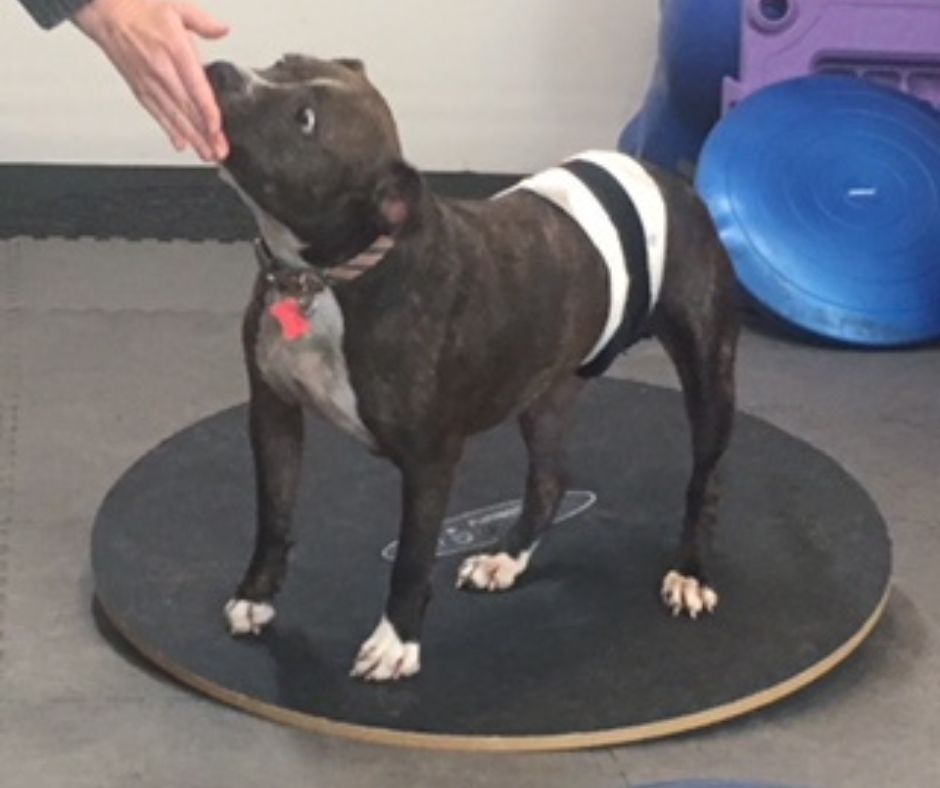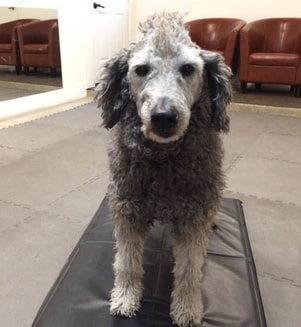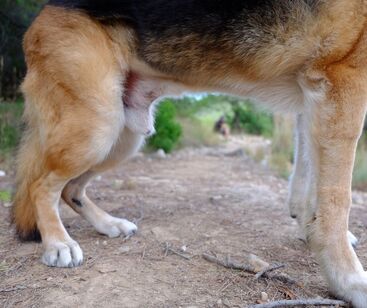Have you ever wondered what a typical day is in the life of a canine physical rehab vet? I’m frequently asked what my days are like, so I thought I’d share it with you.
Here are some common questions I’m asked:
While doctor-client-patient confidentiality prohibits me from saying too much about specific patients, I wanted to share some examples with you. Of course, names and ages have been adjusted to protect the innocent! (and maintain confidentiality).
Here is an example of a common day in my practice. I get to treat a lot of different conditions. Then, I’ll answer any questions not covered below!
A Typical Day of Patients
King’s Story
My first patient arrives and is carried into the gym. He is an older Corgi with a common Corgi issue—degenerative myelopathy. He is 11 now and has had it for two years.
DM is a genetic condition that affects certain breeds. German shepherds and boxers are overrepresented, and I have seen both breeds with this diagnosis.
While he is unable to walk without assistance, he has a dedicated family who do an amazing job of managing his medical condition. They make sure they maximize his quality of life as he progresses through this horrible condition.
He has been my patient for over two years, so we are grateful for our time with him. And I am grateful he has such an amazing family. We discuss where he is for the day, I answer any questions on his care, and we proceed to do some therapeutic exercises to keep his nerves and muscles firing.
King is difficult to motivate, but we are creative and find new ways. He also receives intensive cold laser therapy on his spine.
Riley’s Story
Then, I turn to my next patient, Riley. This pup is actually a geriatric (older than a senior!) Dutch shepherd. She is on a maintenance plan to maintain her mobility as she ages since she has arthritis in multiple joints.
Initially presenting with lower back and hip dysfunction, she now has arthritis in her carpal joints (paws) as well. She has been an active dog throughout her life and continues to maintain mobility now that she is nearly 15.
Riley participates in low-impact exercises based on her capabilities today, and we follow that with laser therapy for multiple joints. She gives kisses and enjoys her one-on-one time with her mom without the “annoying” puppy they have at home.
This one-on-one time with seniors and geriatrics is one of my favorite bonuses of rehabilitation. She truly looks forward to her visits here.
Molly’s Story
My next patient is a dog with intervertebral disc disease (IVDD). This common spinal condition affects many breeds, male and female dogs, and nearly any age.
I have multiple patients with this condition, affected by different degrees of severity and in various degrees of recovery. Molly is post-op from her first back surgery. Sadly, there may be more in the future.
She is a 4-year-old Frenchie learning to use her back legs again. Her back end looks moderately intoxicated as she tries to walk.
Molly gets to work in the gym. I assist her in walking around, stabilizing her back end to prevent “drifting,” and providing a lift when necessary. She also receives laser therapy on her spine to encourage blood flow and promote healing.
Max’s Story
A middle-aged golden retriever arrives next. He is one of my few patients who is reluctant to participate in rehab. Though most dogs enjoy coming to see me, he would prefer to stay home.
However, his mom and I see the importance of rehab since he has multiple mobility issues. Max has elbow dysplasia and arthritis in his knees after he had surgery to stabilize them after rupturing his cranial cruciate ligaments (CCL).
He begrudgingly agrees to exercises to maintain his range of motion and strengthen his joints. Today, we are working on strength exercises to help him get in and out of the car.
We identify a point in the process that may be causing discomfort and modify the movement to make it easier for him. As all four legs have issues, it is even more important that he be in rehab. He also receives laser therapy—this is his favorite part!
Spring’s Story
My next patient is a two-year-old Chihuahua who packs a lot of personality into her tiny little body. Spring has undergone surgery on her right back leg to correct a luxating patella or loose kneecap.
Luxating patellas are a common congenital condition in many small or tiny breeds. Mild cases can be treated with rehab alone. More severe cases require surgery first and then rehab.
Spring has significantly improved in strength, even though her leg will never be 100%. She has already exceeded everyone’s expectations and has a great quality of life.
Bailey’s Story
My next appointment is with a one-year-old German shepherd who has a single issue—he’s had a femoral head ostectomy (FHO) on his right hip. He has decided he can maneuver better on three legs, so we must convince him to use the leg that Mom and Dad paid for surgery on.
As with many patients, pain management is critical to success in rehab, and his medications are ongoing. With him, baby steps help him build strength and confidence in his weak leg.
His progress is slow, but it is still progress.
Rain’s Story
Next, a German short-haired pointer bounces into my gym. He has a strain in his shoulder muscle (the supraspinatus muscle.) This is similar to a rotator cuff injury in people.
I frown, as he is not supposed to bounce. I tell him we’ve had this conversation before and that while I’m glad he feels good enough to bounce, bouncing is not on his list of approved activities at this stage of healing.
Rain ignores me. Because he is young and athletic, following the approved activities list is very difficult for him. His mom tries hard, but we can only control so much.
She diligently works at his home program, which focuses on using pulsed electromagnetic field (PEMF), heat, massage, and transcutaneous electrical nerve stimulation (TENS) to help manage his discomfort and activity level as best she can.
He eagerly participates in his exercises and laser therapy in exchange for small chicken breast pieces.
Delilah’s Story
My next patient, a shepherd mix, hops into the gym. Hopping is necessary for her as she only has one front leg. She is a “tripawd,” so she cannot just walk normally.
Three-legged dogs have to be “above average” in terms of balance, strength, and coordination when compared to four-legged dogs. This is important for them to be functional in their day-to-day lives.
Her moms do a great job of maintaining her ideal weight. She wears a harness, so we have a handle to help when needed. Her exercises are challenging but not high impact as we work to keep her balance optimal and her strength above average.
Delilah is doing well and will continue in rehab every two weeks for maintenance. I remind them that she has “already used her spare tire” and to react quickly if something appears off in any other leg. After her workout, she heads home to take a nap.
Lucy’s Story
My last patient for the day is a middle-aged German shepherd with hip dysplasia. Hip dysplasia is a very common condition I treat, and she is one of many dogs I see for it. It affects all breeds.
Lucy is overweight, so she is on a weight loss plan. We discuss how her diet is going and discuss her pain levels this week. Deciding that we are managing her pain adequately, we proceed with her exercises and laser therapy.
My Work as a Canine Rehab Vet
As a canine physical rehab vet, I work with dogs of all ages and breeds. Some are recovering from injuries, some have congenital issues, and others have conditions due to old age with a possible genetic component.
Though I have seen other animals, like a cat and a goat, most of my patients are dogs. Knowing that I can help and the wide variety of conditions I work with helps keep things rewarding and interesting.
Here are some common questions I’m asked:
- What kind of dogs do I see?
- Do I see other types of animals besides dogs?
- What ages are the animals I see typically?
- What breeds?
- What are the issues I treat?
While doctor-client-patient confidentiality prohibits me from saying too much about specific patients, I wanted to share some examples with you. Of course, names and ages have been adjusted to protect the innocent! (and maintain confidentiality).
Here is an example of a common day in my practice. I get to treat a lot of different conditions. Then, I’ll answer any questions not covered below!
A Typical Day of Patients
- King (corgi with degenerative myelopathy, DM)
- Riley (Dutch shepherd with senior arthritis)
- Molly (Frenchie, who was paralyzed)
- Max (golden retriever with post-operative cranial cruciate ligament rupture (CCL) and elbow dysplasia)
- Spring (Chihuahua with a luxating patella)
- Bailey (German shepherd post-operative femoral head ostectomy, FHO)
- Rain (German short-haired pointer with a shoulder injury)
- Delilah (three-legged “tripawd” dog)
- Lucy (German shepherd dog with hip dysplasia)
King’s Story
My first patient arrives and is carried into the gym. He is an older Corgi with a common Corgi issue—degenerative myelopathy. He is 11 now and has had it for two years.
DM is a genetic condition that affects certain breeds. German shepherds and boxers are overrepresented, and I have seen both breeds with this diagnosis.
While he is unable to walk without assistance, he has a dedicated family who do an amazing job of managing his medical condition. They make sure they maximize his quality of life as he progresses through this horrible condition.
He has been my patient for over two years, so we are grateful for our time with him. And I am grateful he has such an amazing family. We discuss where he is for the day, I answer any questions on his care, and we proceed to do some therapeutic exercises to keep his nerves and muscles firing.
King is difficult to motivate, but we are creative and find new ways. He also receives intensive cold laser therapy on his spine.
Riley’s Story
Then, I turn to my next patient, Riley. This pup is actually a geriatric (older than a senior!) Dutch shepherd. She is on a maintenance plan to maintain her mobility as she ages since she has arthritis in multiple joints.
Initially presenting with lower back and hip dysfunction, she now has arthritis in her carpal joints (paws) as well. She has been an active dog throughout her life and continues to maintain mobility now that she is nearly 15.
Riley participates in low-impact exercises based on her capabilities today, and we follow that with laser therapy for multiple joints. She gives kisses and enjoys her one-on-one time with her mom without the “annoying” puppy they have at home.
This one-on-one time with seniors and geriatrics is one of my favorite bonuses of rehabilitation. She truly looks forward to her visits here.
Molly’s Story
My next patient is a dog with intervertebral disc disease (IVDD). This common spinal condition affects many breeds, male and female dogs, and nearly any age.
I have multiple patients with this condition, affected by different degrees of severity and in various degrees of recovery. Molly is post-op from her first back surgery. Sadly, there may be more in the future.
She is a 4-year-old Frenchie learning to use her back legs again. Her back end looks moderately intoxicated as she tries to walk.
Molly gets to work in the gym. I assist her in walking around, stabilizing her back end to prevent “drifting,” and providing a lift when necessary. She also receives laser therapy on her spine to encourage blood flow and promote healing.
Max’s Story
A middle-aged golden retriever arrives next. He is one of my few patients who is reluctant to participate in rehab. Though most dogs enjoy coming to see me, he would prefer to stay home.
However, his mom and I see the importance of rehab since he has multiple mobility issues. Max has elbow dysplasia and arthritis in his knees after he had surgery to stabilize them after rupturing his cranial cruciate ligaments (CCL).
He begrudgingly agrees to exercises to maintain his range of motion and strengthen his joints. Today, we are working on strength exercises to help him get in and out of the car.
We identify a point in the process that may be causing discomfort and modify the movement to make it easier for him. As all four legs have issues, it is even more important that he be in rehab. He also receives laser therapy—this is his favorite part!
Spring’s Story
My next patient is a two-year-old Chihuahua who packs a lot of personality into her tiny little body. Spring has undergone surgery on her right back leg to correct a luxating patella or loose kneecap.
Luxating patellas are a common congenital condition in many small or tiny breeds. Mild cases can be treated with rehab alone. More severe cases require surgery first and then rehab.
Spring has significantly improved in strength, even though her leg will never be 100%. She has already exceeded everyone’s expectations and has a great quality of life.
Bailey’s Story
My next appointment is with a one-year-old German shepherd who has a single issue—he’s had a femoral head ostectomy (FHO) on his right hip. He has decided he can maneuver better on three legs, so we must convince him to use the leg that Mom and Dad paid for surgery on.
As with many patients, pain management is critical to success in rehab, and his medications are ongoing. With him, baby steps help him build strength and confidence in his weak leg.
His progress is slow, but it is still progress.
Rain’s Story
Next, a German short-haired pointer bounces into my gym. He has a strain in his shoulder muscle (the supraspinatus muscle.) This is similar to a rotator cuff injury in people.
I frown, as he is not supposed to bounce. I tell him we’ve had this conversation before and that while I’m glad he feels good enough to bounce, bouncing is not on his list of approved activities at this stage of healing.
Rain ignores me. Because he is young and athletic, following the approved activities list is very difficult for him. His mom tries hard, but we can only control so much.
She diligently works at his home program, which focuses on using pulsed electromagnetic field (PEMF), heat, massage, and transcutaneous electrical nerve stimulation (TENS) to help manage his discomfort and activity level as best she can.
He eagerly participates in his exercises and laser therapy in exchange for small chicken breast pieces.
Delilah’s Story
My next patient, a shepherd mix, hops into the gym. Hopping is necessary for her as she only has one front leg. She is a “tripawd,” so she cannot just walk normally.
Three-legged dogs have to be “above average” in terms of balance, strength, and coordination when compared to four-legged dogs. This is important for them to be functional in their day-to-day lives.
Her moms do a great job of maintaining her ideal weight. She wears a harness, so we have a handle to help when needed. Her exercises are challenging but not high impact as we work to keep her balance optimal and her strength above average.
Delilah is doing well and will continue in rehab every two weeks for maintenance. I remind them that she has “already used her spare tire” and to react quickly if something appears off in any other leg. After her workout, she heads home to take a nap.
Lucy’s Story
My last patient for the day is a middle-aged German shepherd with hip dysplasia. Hip dysplasia is a very common condition I treat, and she is one of many dogs I see for it. It affects all breeds.
Lucy is overweight, so she is on a weight loss plan. We discuss how her diet is going and discuss her pain levels this week. Deciding that we are managing her pain adequately, we proceed with her exercises and laser therapy.
My Work as a Canine Rehab Vet
As a canine physical rehab vet, I work with dogs of all ages and breeds. Some are recovering from injuries, some have congenital issues, and others have conditions due to old age with a possible genetic component.
Though I have seen other animals, like a cat and a goat, most of my patients are dogs. Knowing that I can help and the wide variety of conditions I work with helps keep things rewarding and interesting.










 RSS Feed
RSS Feed